Metro map of Kiev, information, schemes, history
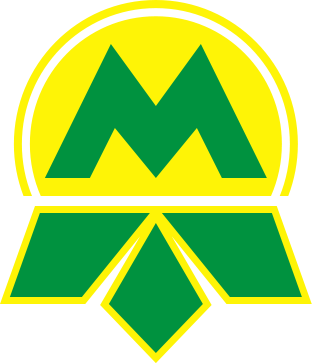
Kiev metro (Ukr. Kyiv Metro) is a high-speed extra-urban transport system of the underground in Kiev (Ukraine). After the opening on November 6, 1960 became the third in the USSR after Moscow and Leningrad. The Kiev metro occupies the 24th place in the world in terms of passenger traffic, although it is only 49th along the length of the lines.
The Kiev Metro is a diversified enterprise, a modern complex engineering complex. It includes 11 operational services, 3 electric depots (TCH-1 Darnitsa, TCH-2 Obolon and TCH-3 Kharkovskoye), a car repair plant (VRZ), and the Metro construction directorate.
Currently (2015), the Kiev Metro has 3 operating lines, the total operating length of which is 67.6 km. To the services of passengers 52 stations with three transfer nodes, located in a triangle in the historical center of Kiev. At all stations of the Kiev subway there is coverage of mobile operators "MTS", "Kyivstar", "Life"  ".
".
The station "Arsenalnaya" of the Svyatoshinsko-Brovarsky line is the deepest in the world and is located at a depth of 105.5 meters (distance from the surface of the earth to the platform).
In Soviet times, the subway was named after VI Lenin, but now it is not indicated in the signboards at the entrance to the station (the words "Lenin's name" were dismantled in the 1990s). In 1981 he was awarded the Order of the Red Banner of Labor.
Simplified scheme of lines of the Kiev underground
Prospects for the development of rail transport in Kiev
Depth of occurrence of stations of the red branch of the Kiev metro
Depth of occurrence of stations of the green branch of Kiev metro
Depth of occurrence of stations of a blue branch of the Kiev subway
September 2 between the stations "Ogorodnyaya" ("Troyeshchina") and "Kiev-Petrovka" began to walk the long promised by the authorities Kiev electric train. According to the plan, it will relieve the passenger traffic on the Moscow bridge in the morning and evening hours and will make life easier for residents of Troyeshchyna, Rainbow and Voskresenka. "Our Kiev" took a ride on one of the evening flights and appreciated the advantages and disadvantages of this transport.
Basic information
- Opening date: November 6, 1960
- Owner: Kyiv City State Administration
- Operator: KP "Kiev Metro"
- Daily passenger traffic: 1.38 million (2014)
- Annual passenger traffic: 503.9 million (2014) / li>
- Awards: Order of the Red Banner of Labor
- Website: www.metro.kiev.ua
- Number of Lines: 3
- Number of stations: 52
- Network length: 69,648 km
- PS Size: 774 cars (2010)
- Number of wagons in the composition: 5
- Number of depots: 3
- Track gauge: 1520 mm (Russian track)
- Electrification: 825 V, contact rail
- Top speed: 90 km / h
Interesting Facts
- The largest launch site - Vokzalnaya-Dnepr 5 stations on November 6, 1960
- The longest was the end - Svyatoshin 32 years (1971-2003)
- The longest distance is Vydubychi-Slavutich 3.4 km away
- The deepest station is Arsenalnaya 105 m to the UGR.
Historical diagrams of the Kiev Metro
- The first scheme of the Kiev Metro.
- 1965 Scheme
- The scheme of 1976 was provided by Mikhal Barashkov (60k)
- Scheme of 1978 from the directory "Streets of Kiev" (80k)
- Scheme 1984 with five lines (198k)
- Scheme 1985 from the booklet "Kiev Metro 25" (91k)
- Scheme of 1985 from encyclopedic reference book "Kiev"
- Scheme of 1989 with the indication of shops, hotels, railway stations (103k).
- The scheme of 1989 from the tourist guide Kiev (121k).
- The scheme of 1991 (59k)
- Scheme 1998 (73k)
- Scheme 2000 from the city plan (175k).
- Scheme of ways of the Kiev underground as of 2003 (23k).
- Scheme for the period until 2010 from the newspaper Vecherniy Kiev from 17.04.2003. (70k)
- The scheme of perspective construction with the location of the depot (70k)
- Scheme-dream of Vitaly Notkin <(131k)
- The scheme for the development of the Kiev Metro from 1960 to 2003 (230 k)
- The official scheme of the sample 2000-2003.
- Surface profile diagram above the SBL.
- The plan for the development of the Kiev Metro until 2020. (1.3 MB !!!)
- The official scheme of the 2005 model.
- Orlov Nikolai Konstantinovich (1913-1990) - early. In 1959 - 1975
- Kapitanuk Stepan Pavlovich (1922-2004) - early. In 1975 - 1985
- Balatsky Nikolai Evtikhievich (born in 1936) - beginning. In 1985 - 2003
- Shavlovsky Nikolai Nikolaevich (r. 1949) - early. 2003 - 2006
- Fedorenko Vladimir Ivanovich (born 1954) - and. about. Early. 2006 - 2007
- Miroshnikov Peter Vladimirovich (born 1957) - early. 2007 - 2010
- Fedorenko Vladimir Ivanovich (born 1954) - early. From October 29, 2010 to May 14, 2014
- Kazylkin Ruslan Anatolyevich - early. From May 14 to July 16, 2014
- Braginsky Victor Vladimirovich (born 1983) - beginning. Since July 17, 2014
- Первая линия , Святошинско-Броварская, чья история начинается 6 ноября 1960 года, имеет протяжённость 22,75 км (из них 6,7 км — наземный участок) и 18 станций. Наземный участок пересекает реку Днепр по двум метромостам. Линия является самой загруженной в Киевском метрополитене. Оценочная предельная длительность поездки составляет 38 минут.
- Вторая линия , Куренёвско-Красноармейская, первый участок которой был введён в эксплуатацию 16 декабря 1976 года, имеет длину 20,95 км и 18 станций. Это единственная линия, которая не пересекает Днепр и не имеет наземных участков. Оценочная предельная длительность поездки составляет 36 минут.
- Третья линия , Сырецко-Печерская, первый участок которой был введён в эксплуатацию 31 декабря 1989 года, имеет длину 23,9 км и 16 станций и один метромост. Оценочная предельная длительность поездки составляет 36 минут.
- «Крещатик» — вестибюль в доме № 19 на Крещатике открыт в 1960 году одновременно со станцией, второй — наземный купольный вестибюль на углу улиц Институтской и Ольгинской (открыт 4 сентября 1965 года) и третий вестибюль —— встроен в дом № 13 по улице Архитектора Городецкого (открыт в конце мая 1970 года);
- «Днепр» — вестибюль находится под станцией, расположенной на эстакаде;
- «Политехнический институт» — вестибюль встроен в здание, в котором расположено управление метрополитена;
- «Гидропарк» — дополнительный вестибюль на восточном выходе построен в 1987 году;
- «Левобережная» — два вестибюля-портала на склоне насыпи, по которой пути подходят к станции, расположены по обе стороны улицы Марины Расковой (построены в ходе реконструкции станции в 1976 году);
- «Дарница» — наземный вестибюль построен в 2006 году на западном выходе в результате реконструкции станции;
- «Черниговская» — два вестибюля в виде стеклянных объёмов по обе стороны Красногвардейской улицы;
- «Золотые ворота» — вестибюль встроен в здания на пересечении Золотоворотского проезда и Владимирской улицы;
- «Дорогожичи» — вестибюль представляет собой здание-платформу, выход из которого устроен в подземном переходе;
Infrastructure
Metro lines cross all 10 districts of the city, but coverage is very uneven: 10 stations in Shevchenkivsky and Pechersky districts, 7 in Darnytskyi and Goloseevskiy, 4 in Obolonsky and Dnieper, 4 in Podolsky and Svyatoshinsky, in Solomenskoye - 2 and, finally, in Desnyanskoye - only one metro station. The land plot of the Sviatoshynsky-Brovarsky line (6.7 km) has 2 bridges - across the river. Dnepr and Rusanov Strait and 2 overpasses. The subway passengers are served by 119 escalators operating at 25 stations.
In 2007, 641.8 million passengers were transported, in 2008 - 663.9 million passengers. In 2009, 502.9 million passengers were transported, in 2010 - 504.3 million passengers, in 2011 - 519.0 million passengers, in 2012 - 526.6 million passengers, for 2013 - 536.2 million passengers .
The busiest stations along the lines (average daily, in 2009): Lesnaya - 64.7 thousand passengers, Vokzalnaya - 66.5 thousand passengers, Petrovka - 52.9 thousand passengers, Lybidskaya - 52,2 thousand passengers, Lukyanovskaya - 22,6 thousand passengers, Poznyaki - 37,8 thousand passengers.
Least loaded stations along the lines: "Dnipro" - 4,2 thousand passengers, "Hydropark" - 7,8 thousand passengers, "Postal area" - 11,2 thousand passengers, "Taras Shevchenko" - 15,5 thousand passengers, Passengers, "Slavutich" - 6,6 thousand passengers, "Red farm" - 5,2 thousand passengers.
The average daily transportation in 2009 and 2010 was 1.38 million passengers. Compared to 2008, passenger traffic decreased by 24%.
| # | Name | End stations | Colour | Put into operation | Number of stations | Length (km) |
|---|---|---|---|---|---|---|
| Sviatoshynsky-Brovarsky | Akademgorodok - Lesnaya | Red | 11/06/1960 | 18 | 22.75 | |
| Kurenivsko-Krasnoarmeiskaya | "Heroes of the Dnieper" - "Teremki" | Blue | 12/17/1976 | 18 | 20.95 | |
| Syretsko-Pecherskaya | "Syrets" - "Red Farm" | Green | 12/31/1989 | 16 | 23.9 | |
| Podolsko-Vigurovskaya | "Ring road" - "Bratislava" , "Miloslavskaya Street" (fork traffic) | Orange | Under construction | 14-20 | ~ 16 | |
| Left bank | "Miloslavskaya Street" - "Osokorki-Yuzhnye" | Blue | Designed | 18 | ~ 11.5 | |
| Total: | 52 | 67.6 km |
Before construction starts
The Metropolitan in Kiev could appear after London. It was possible to find out that in Kiev for the first time they offered to go deeper under the ground in 1884. But it was then not about the "subway" of the British or American, but about the section of the railway in the tunnel. It was proposed to lay rails along the embankment, and then a tunnel. He was to enter the slope below the Postal Square and get to the surface in the area of Bessarabka. It was planned to build a new passenger station, and the one that was behind the river. Turn the Lybid into a freight station. The proposal was discussed for a long time but the City Duma rejected it.
Another real possibility of building a subway in Kiev appeared in September 1916, when the head of the Kiev branch of the Russian-American Chamber of Commerce addressed the city head with proposals for improving the transport connection in the city. He wrote: "The development of Kiev is going on at a fast pace both in terms of population growth and the development of bustling commercial activity." The peculiar conditions of Kiev: the remoteness of residential areas from the commercial center, the exorbitant high cost of flats in the neighborhoods of the central and neighboring cities, , Its mountainous position, mainly the commercial nature of the population-all this puts forward first and foremost the question of a cheap, soon and safe in all respects communication.The Kiev city tram does not at present answer any of these conditions. The development of a tram network can not keep up with the city's development ahead of it.The increase in the number of wagons on the main lines threatens to slow down traffic, and an increase in the speed of wagons threatens the safety of people. The only way out of this situation is the gradual transition from Ground tram to the underground, starting from the main streets. "
December 7, 1916 the Acting President. City mayor Fyodor Burchak responded to the Russian-American Chamber of Commerce: "The City Council, having discussed in detail the proposal of the Chamber, agreed in principle to attracting American capital to the equipment of the city of Kiev by high-speed communications with the participation of the City Administration in the US capital enterprise, Net concession method of organizing urban enterprises in the future for the City Administration is unacceptable. "
The Chamber of Commerce was not counting on such an answer, thinking exactly about the concession. But she did not abandon her plans and in January 1917 she asked for statistical data on Kiev. It was planned to deploy in America campaigning to attract capital for the construction of a subway in Kiev. These were the very first steps to the Kiev metro, remaining unrealized because of the revolutionary 1917-th.
And yet in June of the following year, after a catastrophic explosion of artillery shells on the Zverinets (they were in the triangle between the modern streets of Bastionnaya and Kikvidze), the Metro was again spoken. It was about the plans of the government of the hetman of the Ukrainian state Pavel Skoropadsky to turn the injured Zverinets into the best district of Kiev. To build here a government center with a hetman's palace, to place the institutions and institutes of the Academy of Sciences, to arrange a central market equipped with the latest technology, through which the city would be provided with all the necessary goods and products.
The correspondent of the newspaper Vozrozhdenie after the meeting with the Deputy Minister of Railways Engineer Chubinsky wrote: "Lifting trucks, both cargo and passenger, are much better than those on the Mikhailovsky upswing (it is said about the cable car), they will lift people and cargo from the Dnieper, Coast to Zverinets or to Kiev.We will build a water pipeline, sewerage, a power plant and a tram, which is currently of great importance.The construction of trams is planned, except for such as now, ground, also in tunnels, which are called underground. Kiev, which is the best for this construction, Kiev stands on the mountains and plains created by nature itself, and the subway, emerging from the mountain tunnel to the plain and again passing through the tunnel, will transport everyone and everyone from Bessarabka to Demievka, with Zoo on Lukyanovka, from the Quay or the Proreznaya to the Zadneprovsky Slobodka. " However, these bright prospects were not to be realized so soon, since on December 14, 1918, power from Hetman Skoropadsky was transferred to the Directory of Simon Petliura.
Almost 20 years have passed, when plans for the metro in Kiev began to acquire a certain reality. July 9, 1936 the Presidium of the Kyiv City Council examined the thesis work of the graduate of the Moscow Institute of Transport Engineers Papazov "Project of the Kiev Metro." The protocol noted that the author "successfully approached the resolution of one of the issues of the reconstruction of Kiev and the arrangement of intraurban transport, and successfully developed some practical questions of the subway scheme." For this project, the engineer received a 1000 rubles prize from the city.
Rumors spread about the rapid construction of the metro, and letters began to come to Kyiv from specialists in mining and mining with proposals for their services. The city council answered negatively until the time, but in 1938 preparatory work began, which was interrupted by the Great Patriotic War.
Prehistory
In 1884, for the first time in the Russian Empire, the draft of the underground railway was considered in Kiev. The project provided for the construction of tunnels from the wharf on the Dnieper to the railway station through Pochtovaya Ploshchad and Bessarabka. However, the deputies of the city duma rejected this project - it is likely, because of the banal fear of the unknown. It also happened in Moscow, where the projects of 1902 and 1912 failed. The idea of creating high-speed urban transport in Kiev is again considered in 1916. Then members of the Russian-American trading company tried to raise money to create a metro in Kiev [10]. However, the city government refused the trading company. In 1918, the metro was recalled again - it was connected with the plans of the hetman of Ukraine Pavel Skoropadsky to turn the Zverinets area into the best district of the city. These plans, too, were not destined to come true, since the power of Hetman Skoropadsky was transferred to Simon Petliura.
Only after twenty years plans for the construction of the metro in Kiev found credibility. On July 9, 1936, the Presidium of the Kyiv City Council examined the thesis project of the graduate of the Moscow Institute of Transport Engineers Papazov "Project of the Kiev Metro". For this project, a young engineer was awarded a prize of 1000 rubles. [11] According to Kiev, there were rumors that a subway would be built in the city in a short time; This led to the fact that letters from mining specialists began to arrive in Kiev with proposals to help in the design and construction. The Kyiv City Council for some time responded not in favor of the metro, but in 1938 preliminary works began that stopped with the outbreak of the Great Patriotic War.
Sviatoshynsky-Brovarsky
In August 1949, the management of "Kievmetrostroy" started the construction of a subway in Kiev. The first section of the Svyatoshinsko-Brovarsky line with a length of 5.2 km from the station. "Vokzalnaya" to the station. Laquo; Dnepr "entered service on November 6, 1960. Then the wagons were serviced in the temporary depot" Dnepr ", and the station itself had a very unusual design. In 1963 a site was put into operation in the west direction with two stations of 3,4 km length, during the construction of the tunnel, concrete tubing began to be used. Since 1965, the metro has crossed the Dnieper on a two-tiered Metro Bridge to the left bank and acquired the electric depot "Darnitsa". Since June 1, 1970, the composition of electric trains has been increased. Instead of 3 cars on the line came 4-car trains. Since 1972, 5 wagon trains run. In 1987 between Art. "University" and "Khreshchatyk" built art. "Leninskaya", now "Teatralnaya", specifically as a transfer to the Syretsko-Pecherskaya line. Since the autumn of 2000, construction of a 3-kilometer section of the Svyatoshin-Brovary line in the western direction began. The work was carried out, albeit on a scale scale, two stations, Prospekt Pobedy and Prospect Palladina (the pilot names of Zhytomyr and Akademgorodok stations) were built in parallel, but with interruptions due to irregular financing. From 14.01.2001 to 25.12.2002 the part of the Victory Avenue under which the section of the line passed was blocked. On May 24, 2003, the section from the station was commissioned. "Svyatoshin" to the station. "Akademgorodok." The current line with 18 stations, serviced by 271 cars, runs from west to east, crossing the Dnieper and Rusanivsky straits across the bridges. The length of the line is 22.7 km, the travel time is 38.5 minutes.
Kurenevsko-Krasnoarmeiskaya
In 1971, the construction of the first section of the line began. In December 1976, a section of the Kurenivka-Chervonoarmiiska line with a length of 2.3 km from the station began to operate. "Square of the October Revolution" is now "Independence Square" to the art. The "Red Square" is now "Kontraktovaya Ploshchad". Within 6 years, a site was completely built in the northern direction, which connected the residential area of Obolon with the city center, and also the "Obolon" electropower was commissioned. The construction of the southern section was frozen from 1984 to 2005. In connection with the need to cross the underground channel of the Lybid River, at that time there were no technologies to do this, at a reasonable cost. Since 2005, the construction of the southern section of the line has been continued. In the winter of 2006, an accident occurred on the construction of the Demeevskaya station - the wall of the future station collapsed and a gantry crane plunged into the pit. Fortunately, no one was hurt. On December 15, 2010, as always after several shifts, a 4 km stretch was opened with three stations in the south direction. The operating line with 15 stations, served by 220 cars, runs from north to south, has a length of 17.2 km, travel time 35 min.
Syretsko-Pecherskaya
In 1981, the construction of the third line of the Kiev Metro was started. On December 31, 1989, the first section of the Syretsko-Pecherskaya metro line with the length of 2.1 km from the station was put into operation. "Golden Gate" to the station. "Mechnikov" now "Klovskaya" construction of the south-eastern section, which crosses the Dnieper along the South Bridge, was completed in 1994. The station "Pecherskaya", built since 1989, was opened to passengers only in 1997. In 1996, the first section of the north-western direction was launched with three stations, one of which, the "Lviv Brama", is not operated and is in semi-preserved condition, due to the lack of an inclined tunnel. After regular shifts of the opening date (14.10.1999, 30.12.1999) on March 30, 2000, the 40th station of the Kiev metro Dorogozhichi entered service. Due to the transfer of the land for the depot, the southeastern section is extended by 3.3 km, 3 stations are planned on this stretch. The first of these "Boryspilska" was opened on August 23, 2005. In March 2006 the Art. "Vyrlytsia", it is located between the station. "Kharkov" and art. «Boryspilskaya». The construction of the third station - "Krasny Khutor" is now under way. The depot Kharkovskoye was opened on August 23, 2007, but it did not start functioning until the end of January 2008. The length of the station with 16 stations is 22.8 km, it is serviced by 248 cars, and the journey time is 38 minutes.
Podolsko-Resurrection
2005 can be considered the year of the beginning of the construction of the line, although underground works are not conducted yet. The stations at the Podolsky bridge crossing are under construction. The construction of the fourth line of the Kiev Metro is restrained by the pace of construction of the Podolsky bridge crossing. The opening of the facility was planned in 2014, when the third (final) construction phase will be completed [15]. As of 2015, the plant underpasses the bridges overpasses.
Heads of the Kiev underground
Ad Language
In the 1960s, Ivga Kuznetsova, a lecturer at the University of Kiev, succeeded in making the announcement in the Ukrainian capital in the metro only in Ukrainian. But in the first half of the 1980s the stations in the Kiev metro had already been announced only in Russian. Moreover, before February 1984, when the train was sent, instead of "Caution, the door is closed", the phrase "Doors closed" sounded just like the phrase "Cautiously, doors are closed", it only got in February 1984. When the train arrived at the final station, the phrase "The train does not go any further." Please, free the wagons. " This method remained unchanged until November 1987. From November 1987 until July 16, 1990, when the Declaration on the Sovereignty of Ukraine was adopted, the announcement was bilingual: the arrival of the train to the station was announced in Ukrainian, and the departure in Russian. Since August 1990, announcements of stations have only been made in the Ukrainian language. Since May 2012, ads in the Kiev Metro are partially duplicated in English.
Metro in general
Now the total length of subway lines with 49 stations located on them is 63.7 km. Each line is serviced by its electric depots - Darnitsa, Obolon and Kharkivskoye. For the period until 2010, the construction of the fourth line is planned, the actual design of the line was ready 20 years ago from Zhulyan to Voskresenka and Troyeschina, but the cost of the bridge across the Dnieper, Desenka and Voskresensky Gardens is about $ 500 million, which is beyond the capacity of today's capital budget. So, that in the near future the fourth line in Kiev to the left bank will not reach. There is a construction project and the fifth Pridneprovskaya line it was to pass from the Troyeshchina residential area along the Dnieper to Pozniaky (I will stage the Poznyaki even as a transplant). When and in what form this plan will be implemented is not yet known. In the city administration there is a debate about the feasibility of building a new metro line. Decided to build a high-speed tram, it is much cheaper than the subway.
Metropolitan today
Today the Kiev Metro has three operating lines with 52 stations, the operational length of the tracks is 67.6 km. In the Kiev metro there are three underground interchange nodes in the city center. At the moment Podolsko-Vigurovskaya line is under construction and Levoberezhnaya is being designed. Of the 52 stations of the Kiev Metro 6 - ground. Из подземных станций 20 глубокого заложения и 26 — мелкого. Станции глубокого заложения в Киевском метро в основном пилонные, есть 3 станции колонного типа, а также имеется единственная в СНГ станция «лондонского типа» (без центрального вестибюля) — «Арсенальная». Станции мелкого заложения по конструкции разделяются на колонные (13 станций) и односводчатые (8 станций). Среди колонных станций мелкого заложения можно выделить три двухпролётные станции: «Позняки», «Вырлица» и «Красный Хутор»; три станции с высоким сводом центрального зала — «Академгородок», «Демиевская» и «Ипподром». Три станции имеют боковые платформы, две из них (обе — на третьей линии) — «Вырлица» и «Красный Хутор» — станции мелкого заложения, и наземная станция «Днепр», остальные станции имеют островные платформы. Самой глубокой станцией является станция «Арсенальная» (105,5 м). В настоящее время эта станция считается самой глубокой в СНГ и Европе. На третьей линии есть две неоткрытые станции — «Теличка» и «Львовская брама», они не имеют выходов на поверхность, однако сами станции построены в конструкциях и готовы на 30-70 %; а также задел под станцию «Герцена», которая находится между станциями «Лукьяновская» и «Дорогожичи». При этом их можно назвать «долгостроями», так как они находятся в «замороженом» состоянии свыше 15 лет.
Линии метрополитена соединены между собой переходами: «Площадь Независимости» — «Крещатик», «Дворец спорта» — «Площадь Льва Толстого» и «Театральная» — «Золотые ворота». В метрополитене имеется 127 эскалаторов, которые размещены на 26 станциях, в том числе 122 действующих эскалаторов на 25 станциях. Энергетическая система метрополитена включает разветвлённую кабельную систему, 52 совмещенные тягово-понижающих подстанций, 2 тяговые подстанции, 14 трансформаторных подстанций. Управление ими осуществляется с автоматических диспетчерских пунктов. Габариты приближения строений, оборудования и подвижного состава линий киевского метрополитена соответствуют требованиям ГОСТ 23961-80.
Architecture
Киевский метрополитен не является исключением среди систем метро Советского Союза, известных своим ярким и красочным художественным оформлением. Станции первого периода были оригинально продуманы и декорированы в стиле послевоенной советской архитектуры, смешанной с традиционными украинскими мотивами. Станции второго периода имели уже не такое красочное, более строгое оформление. Функциональные возможности стали самым важным фактором в более новых проектах, и оригинальность оформления отошла на второй план. Станции, построенные в тот период, были практически одинаковы. Лишь в середине 1970-х годов декоративная архитектура начала возрождаться. В 2012 году станция «Золотые ворота» вошла в список из 22 самых красивых станций метрополитена Европы (по версии британской газеты Daily Telegraph).
Наземные вестибюли есть на пятнадцати станциях: «Вокзальная», «Университет», «Крещатик», «Арсенальная», «Днепр», «Политехнический институт», «Шулявская», «Гидропарк», «Левобережная», «Дарница», «Черниговская», «Сырец», «Дорогожичи», «Лукьяновская», «Золотые ворота». Of them:
На остальных станциях выходы совмещены с подземными переходами, в том числе на 16-ти станциях («Оболонь», «Петровка», «Тараса Шевченко», «Святошин», «Дарница», «Лесная», «Дворец Спорта», «Вырлица», «Бориспольская», «Красный Хутор», «Демиевская», «Голосеевская», «Васильковская», «Выставочный центр», «Ипподром», «Теремки») переходы сделаны в виде крытого стеклянного павильона («стекляшки»), на станциях «Контрактовая площадь» и «Площадь Льва Толстого» ближайшие к станции выходы из подземного перехода устроены в зданиях, причём на «Площади Льва Толстого» — в здание инженерного корпуса метрополитена. На станции «Героев Днепра» два полуподземных вестибюля встроены в автодорожную развязку, выход осуществляется на круглую площадь внутри развязки. В начале 1990-х годов некоторые станции были переименованы (это было связано с декоммунизацией). Некоторые из советских символов, первоначально включённых в интерьер станций, были удалены.
Хронология открытия участков
Цвета названий станций соответствуют цветам линий метро на которых они находятся.
6 ноября 1960 года: «Вокзальная» — «Днепр» (без «Ленинской» (ныне «Театральная»))
5 ноября 1963 года: «Вокзальная» — «Завод „Большевик“» (ныне «Шулявская»)
5 ноября 1965 года: «Днепр» — «Дарница»
4 октября 1968 года: «Дарница» — «Комсомольская» (ныне «Черниговская»)
5 ноября 1971 года: «Завод „Большевик“» (ныне «Шулявская») — «Святошино» (ныне Святошин)
17 декабря 1976 года: «Площадь Калинина» («Площадь Октябрьской революции», ныне «Площадь Независимости») — «Красная площадь» (ныне «Контрактовая площадь»)
4 декабря 1979 года: «Комсомольская» (ныне «Черниговская») — «Пионерская» (ныне «Лесная»)
19 декабря 1980 года: «Красная площадь» (ныне «Контрактовая площадь») — «Проспект Корнейчука» (ныне «Оболонь»)
19 декабря 1981 года: «Площадь Октябрьской Революции» (ныне «Площадь Независимости») — «Республиканский стадион» (ныне «Олимпийская»)
6 ноября 1982 года: «Проспект Корнейчука» (ныне «Оболонь») — «Героев Днепра»
30 декабря 1984 года: «Республиканский стадион» (ныне «Олимпийская») — «Дзержинская» (ныне «Лыбедская»)
6 ноября 1987 года: «Ленинская» (ныне «Театральная»)
31 декабря 1989 года: «Золотые ворота» — «Мечникова» (ныне «Кловская»)
29 декабря 1991 года: «Мечникова» (ныне «Кловская») — «Выдубичи» (без «Печерской»)
30 декабря 1992 года: «Выдубичи» — «Осокорки» (без «Телички»)
28 декабря 1994 года: «Осокорки» — «Харьковская»
30 декабря 1996 года: «Золотые ворота» — «Лукьяновская» (без «Львовской Брамы»)
27 декабря 1997 года: «Печерская»
30 марта 2000 года: «Лукьяновская» — «Дорогожичи»
24 мая 2003 года: «Святошин» — «Академгородок»
14 октября 2004 года: «Дорогожичи» — «Сырец»
23 августа 2005 года: «Харьковская» — «Бориспольская» (без «Вырлицы»)
4 марта 2006 года: «Вырлица»
23 мая 2008 года: «Бориспольская» — «Красный Хутор»
15 декабря 2010 года: «Лыбедская» — «Васильковская»
27 декабря 2011 года: «Васильковская» — «Выставочный центр»
25 октября 2012 года: «Выставочный центр» — «Ипподром»
6 ноября 2013 года: «Ипподром» — «Теремки»
Планы строительства и перспектива
По проекту Генерального плана развития Киева до 2025 года, разработанному КО «Институт Генерального плана г. Киева» в 2011 году, планируется строительство новой ветки метро с массива Троещина к аэропорту Киев, Сырецко-Печерскую линию продлить к массиву Виноградарь, предусмотрено строительство депо на Куренёвско-Красноармейской линии за станцией Теремки. Также предусмотрено строительство пересадочных узлов возле станций городской электрички. Кроме того, существовали планы по дополнению системы метрополитена линиями лёгкого метро системы РАДАН разработки ГП Антонов.
Продление Святошинско-Броварской линии
Планируется сооружение второго выхода на ст. м. «Вокзальная». Предварительно планируется продление линии до жилого массива Новобеличи (сроки неизвестны).
Продление Куренёвско-Красноармейской линии
Продление Куренёвско-Красноармейской линии в направлении Теремков было запланировано на начало 1980-х годов, однако вскоре работы были свёрнуты и предпочтение отдано строительству Сырецко-Печерской линии. В 2005 году возобновлено строительство участка от станции «Лыбедская» до станции «Выставочный центр» и далее до «Теремков». Ранее планировалось, что участок от станции «Лыбедская» до станции «Васильковская» будет сдан в эксплуатацию в 2007 году, но из-за недостаточного финансирования и сложных геологических условий сроки были перенесены сначала на 2008 год, а затем и на 2009 год. Фактически станции открылись 15 декабря 2010 года. 27 декабря 2011 года открыта станция «Выставочный центр». 25 октября 2012 года открыта станция «Ипподром». 6 ноября 2013 года открыта станция «Теремки».
Продление Сырецко-Печерской линии
Одобрено продление Сырецко-Печерской линии до станции «Синеозёрная», предполагается, что строительство этого участка закончится в 2016 году[26].Тем не менее, данные сроки крайне сомнительны, учитывая объём работ и сложности с финансированием. Рассматривался также проект продления линии от станции «Красный хутор» до железнодорожного вокзала «Дарница». Впоследствии линию планируется достроить до станции «Левобережная».
Подольско-Вигуровская линия
До 2004 года называлась Подольско-Воскресенской. Станет исторически четвёртой линией Киевского метрополитена и соединит юго-запад Киева с северо-востоком, пройдя от аэропорта Киев (Жуляны) вдоль Воздухофлотского проспекта, через Севастопольскую, Соломенскую площади, затем, через железнодорожный вокзал, площадь Победы, Лукьяновку, Татарку, Подол, Труханов остров, линия пройдёт до массива Радужный (Серова-Радужный), бульвара Перова и Братиславской улицы Воскресенского массива и Вигуровщины-Троещины. Предполагалось, что первая очередь Подольско-Вигуровской линии свяжет две линии Киевского метро — Сырецко-Печерскую линию и Куренёвско-Красноармейскую линии, тем самым позволив разгрузить пересадочные узлы в центральной части города. На линии ранее предлагалось устроить вилочное движение — от станции «Радужная» поезда пойдут как в сторону станции «Братиславская», так и в сторону станции «Улица Милославская». В 2011 году предлагалось выделить из горбюджета 8,9 млн. гривен на начало строительства первой очереди ветки метро от станции «Глубочицкая» до станции «Радужная» у одноимённого массива, а также на перестройку скоростного трамвая на Троещине в метро. Запустить первую очередь планировали в 2014 году. Однако продолжение строительства отложено на неопределённый срок, а первая очередь будет только от станции «Подольская» до станции «Радужная».
Левобережная линия
Трасса линии проходит и ранее планировалась взамен линии Киевского скоростного трамвая по улице Оноре де Бальзака на Троещине. Сроки сдачи первой очереди линии от станции «Улица Милославская» до станции «Проспект Ватутина» назывались не ранее 2019 года, однако с принятием трассировки метро по проспекту Маяковского, стали неизвестны. В перспективе эту линию планировалось продлить на юг по левому берегу Днепра в направлении Осокорков. Трасса Левобережной линии проектировалась по улице Оноре де Бальзака от ул. Милославской до проспекта Ватутина, мимо ж/д ветки до Броварского проспекта с пересадкой на Святошинско-Броварскую линию (ст. «Левобережная») и ответвлением на Подольско-Вигуровскую линию в районе нынешних Русановских садов. Первоначальное название линии — Приднепровская (согласно планам 1980-х годов). Её трасса должна была проходить от села Зазимье Броварского района через жилой массив Вигуровщина-Троещина, Русановские сады, новые жилые районы на юго-востоке города и заканчиваться в селе Вишенки Бориспольского района Киевской области.
Вышгородско-Дарницкая линия
Проектом Генерального плана Киева, обнародованном в 2012 году, более чем вдвое планируется увеличить общую протяженность метрополитена и количество его станций. Линия предлагалась и оговаривалась, как пятая, на замену Левобережной, на месте которой сейчас действует Киевский левобережный скоростной трамвай № 4,5. Её трасса планируется от Куреневки через Краснозвездный проспект и Печерск в сторону Ленинградской площади и Дарницкого Ж/Д вокзала. Будет иметь пересадки со станциями Шулявская, Дорогожичи (возможно так же Герцена), Чоколовская, Лыбедская (Демиевская), Дружбы народов. Дата открытия неизвестна.
Оплата проезда
Жетоны разных годов
Жетоны, выпущенные к 50-летнему юбилею метрополитена
| Тариф за одну поездку | Дата введения |
|---|---|
| 50 копеек | 12 ноября 1960 года |
| 5 копеек | 1 января 1961 года |
| 15 копеек | 2 апреля1991 года |
| 30 копеек | 2 января 1992 года |
| 50 копеек | 27 апреля 1992 года |
| 5 карбованцев | 26 декабря 1992 года |
| 15 карбованцев | 5 июня 1993 года |
| 30 карбованцев | 10 сентября 1993 года |
| 150 карбованцев | 6 декабря 1993 года |
| 200 карбованцев | 11 августа 1994 года |
| Тариф за одну поездку | Дата введения |
|---|---|
| 1500 карбованцев | 1 ноября 1994 года |
| 7000 карбованцев | 1 февраля 1995 года |
| 10000 карбованцев | 7 сентября 1995 года |
| 20000 карбованцев | 7 февраля 1996 года |
| 20 копеек | 2 сентября 1996 года |
| 30 копеек | 15 декабря 1996 года |
| 50 копеек | 19 марта 2000 года |
| 2 UAH | 4 ноября 2008 года |
| 1 гривна 70 копеек | 31 января 2009 года |
| 2 UAH | 6 сентября 2010 года |
| 4 гривны | 7 февраля 2015 года |


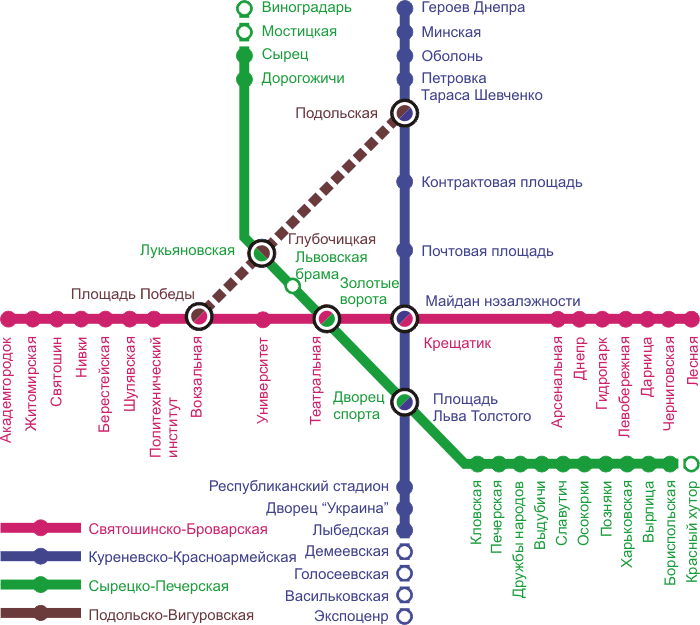
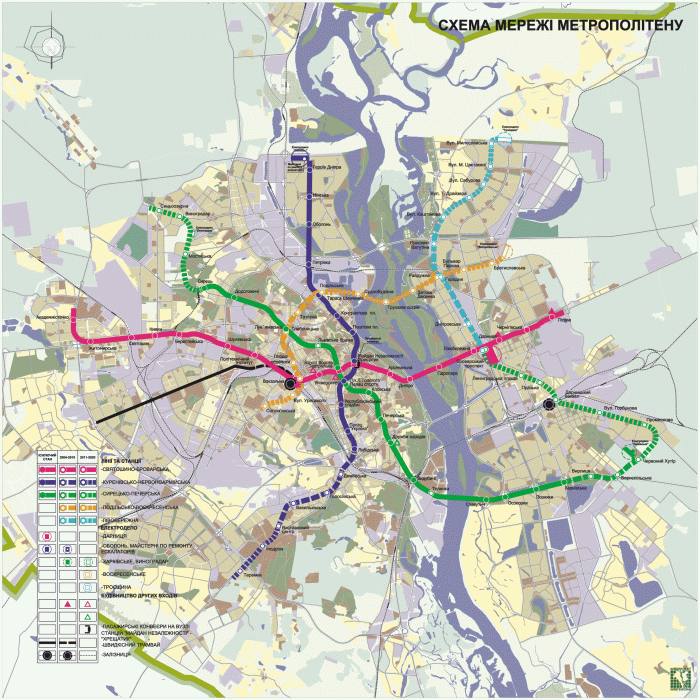
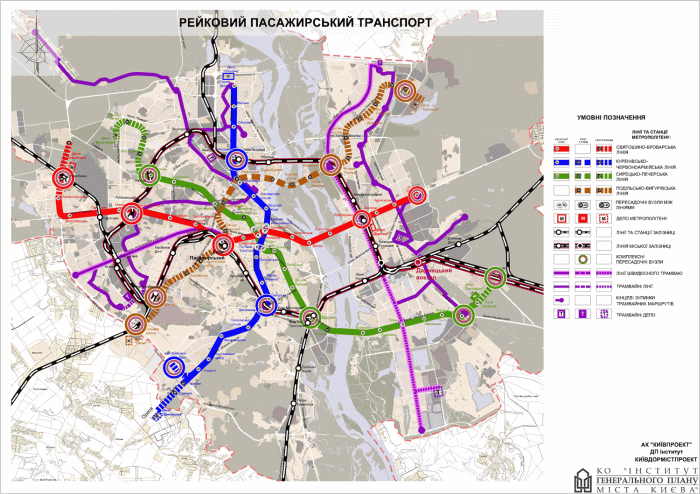
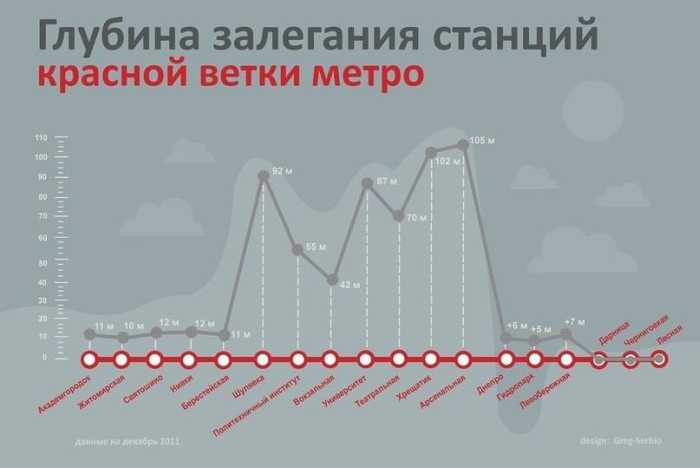



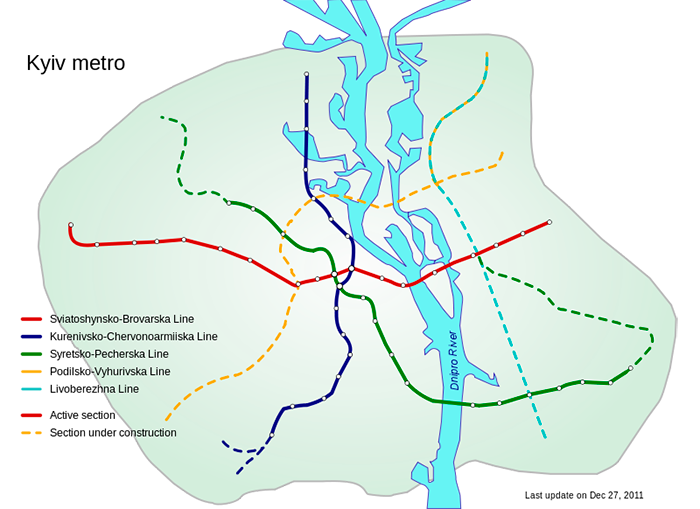
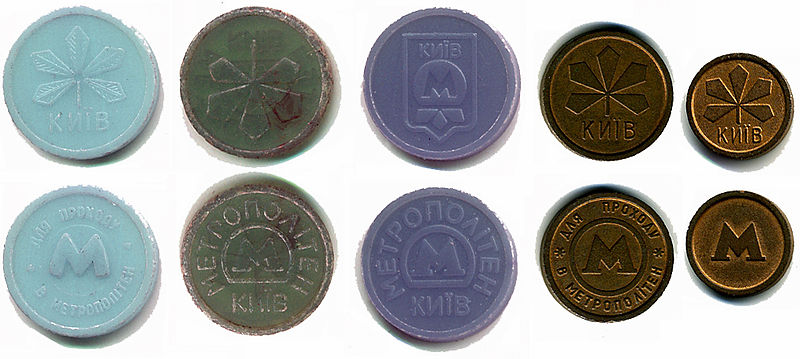


Comments
Commenting on, remember that the content and tone of your message can hurt the feelings of real people, show respect and tolerance to your interlocutors even if you do not share their opinion, your behavior in the conditions of freedom of expression and anonymity provided by the Internet, changes Not only virtual, but also the real world. All comments are hidden from the index, spam is controlled.